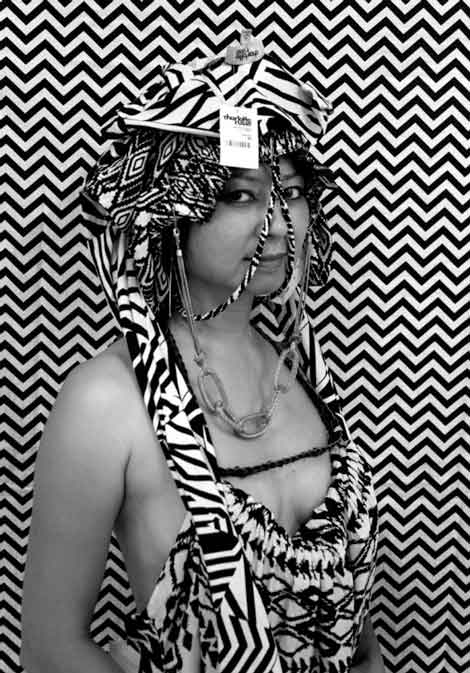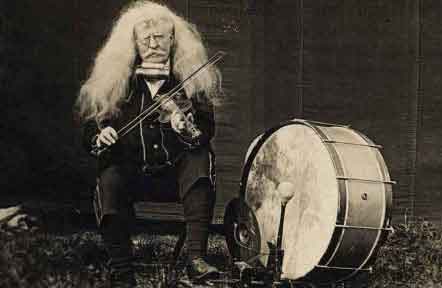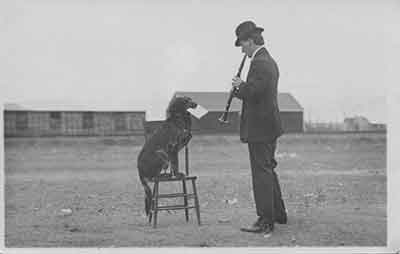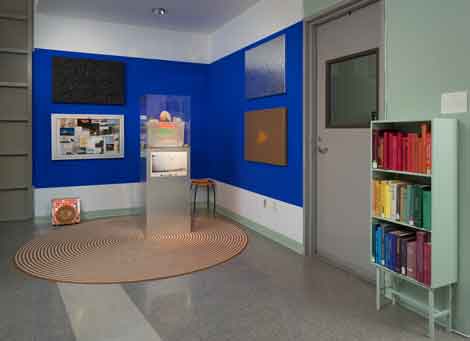For many centuries, the wunderkammer model of organizing collections of art and objects of curiosity was de rigueur. The earliest wunderkammer, or cabinets of curiosity, were the private collections of wealthy Europeans, including Rudolf II, Holy Roman Emperor, Ole Worm and Charles I of England. They demonstrated their prominence and intellect through amassing splendid specimens from the natural world, works of art, religious relics, antiquities and more. The organization was free-form and nonhierarchical, interdisciplinary and the epitome of art for art’s sake. The intent of these marvelous collections was both to amaze and to inform; the spreading of knowledge came about through the piquing of curiosity.
The wunderkammer model was replaced, however, with a more rigidly stratified system for the display of art and scientific objects. Museums founded in the 19th century and after relied upon inflexible codes and conventions that more often than naught exemplified their founders’ Western-centric, patriarchal and elite mindsets. The rules regarding who was included and who was excluded tended to be ossified. Science and art were separated, and hierarchy entrenched.
It is no wonder, then, that in today’s art world, in which arbitrary boundaries are now questioned and the politics of exclusion probed, that the wunderkammer has gained a new popularity as an organizational and methodological mode for exhibitions that can offer a much more invigorating and authentic viewing experience.
The “Wunderkammer” show at the Pitzer College Art Galleries, curated by Ciara Ennis, is a compelling take on the cabinet of curiosity’s contemporary relevance. At first glance, the assembled artworks in all possible mediums appear startlingly disparate, but unity is found first in the cool pistachio-colored paint that washes sections of gallery walls and lines the edges of tables and floorboards, and then, more importantly, in the various ways the included pieces explore our relationship with history, critique existing power structures and the channels that control and disseminate knowledge, challenge our ingrained notions of the function and meaning of objects, and, in the grand tradition, celebrate the idiosyncratic, the wondrous and the mundane.
Ennis has wisely included a wunderkammer-within-a-wunderkammer, choosing to exhibit some of the eccentric Los Angeles denizen Clare Graham’s pieces from his collection of over 7,000 objects. There are multiple display cabinets and cases, one with ethnographic offerings from Papua New Guinea, another with funky objects, such as melting stamps, balloon molds and funnels. Around the gallery are other pieces, such as “punk cats”—carnival knock-down cats—a collection of glass eyes and a deformed elk skull with antlers. The inclusion of a modern day wunderkammer is an excellent starting point for the show, as it evokes the same sense of wonderment and nostalgia of those of earlier eras.

Steve Roden’s Vernacular and Professional Photographs, 1880-1955 (2006-2011), Collection of black and white, sepia photographs, Dimensions variable, Courtesy of the artist.
Indeed, nostalgia, both straightforward and complicated, is a key theme in the show. Steve Roden’s collection Vernacular and Professional Photographs, 1880–1955 (2006–11) features three glass display tables exhibiting several dozen black-and-white or sepia photographs of musicians or images relating to music and sound. Roden collected them from flea markets and other secondhand sources, reveling in the way they indicated sound but were essentially mute. There is both distance and familiarity in these images of people from decades past immersed in activities that still occupy us today. Nina Katchadourian’s Once Upon a Time in Delaware/In Search of the Perfect Book from the “Sorted Books” project (2012) features a carefully curated selection of reproductions of the highly gilded covers of American fiction and nonfiction from 1870–1920. She places covers of similarly themed works together in groups of three, allowing her selections to comment upon the predilections and preoccupations of Americans in a time of industrial boom, world war and the birth of modernism. One group anxiously comments on isolation and distance (An Unsocial Socialist/Adrift on an Ice Pan/ At the North Pole), another on women in society (Queen of the Air/Her First Appearance), while another celebrates national pride (Strange Stories of the Revolution/Wee MacGreegor Enlists/For France). The collection provides a fresh lens through which to glean the character of an era.
Chris Wilder’s corner of the gallery takes up the theme of the belief in extraterrestrial beings, which relies on a lack of material evidence to support it. He calls attention to the government’s exploitation of these beliefs in order to push citizens into supporting other seemingly unrelated policies. The reference to ETs and UFOs alludes to the inclusion in historical wunderkammer of hoaxes and pseudo-scientific specimens, such as the passing off of narwhal tusks for unicorn horns.

Stephanie Syjuco, Cargo Cults series (2013/2014) C-Prints, 40 x 30 in. each
Courtesy of the artist and Catharine Clark Gallery.

Stephanie Syjuco, Cargo Cults series (2013/2014) C-Prints, 40 x 30 in. each
Courtesy of the artist and Catharine Clark Gallery.
Several of the pieces lure the viewer in with their beauty and then expose themselves as something far more complicated. Melanie Nakue’s Aesthetics of Labor Series (2007) is a modernist grid of digital images that seduces with its decorative loveliness, but the images reference the quilt patterns of the indigenous Hawaiians, who were taught the practice by European missionaries during the age of imperialism and used the medium to celebrate their own flora and fauna. Stephanie Syjuco’s Cargo Cults series (2013/2014) is four large C-prints of the artist herself, draped in graphically bold clothing to emulate vintage ethnographic images. She comments on capitalism’s global hegemony through the cheap clothing, purchased from chain stores like Gap and Forever 21 and later returned so as not to contribute to the capitalist cycle, and the title of the piece, which references the fetishization of commodities dropped on Pacific islands during WWII.
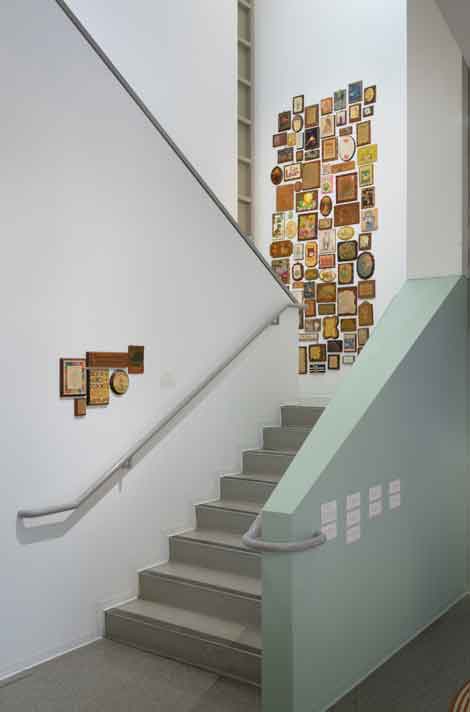
Michael Decker, That’s Not The Way It Feels (2015), Collection of wooden wall plaques, Dimensions variable, Courtesy of artist.
As in true wunderkammer fashion, not all of the pieces exhibited are easily categorized as art objects, or their creators/discoverers as “true” artists. David Bachman, a mathematics professor at Pitzer, creates fossil or shell-like shapes using mathematical models, which are then rendered from a 3D printer. Michael Decker’s That’s Not The Way It Feels (2015) is a collection of small, kitschy plaques with homespun platitudes on them, as would be hung in country kitchens or grandmothers’ dens. These objects—which Decker found at thrift stores over a period of six years—transcend their banality and are a testament to the universal desires of love, friendship and family. Joshua Callaghan takes a familiar and equally quotidian object—the keychain—and magnifies it a hundredfold, creating a huge hanging sculpture comprised of furniture and wood parts. Now essentially functionless and absurd, Callaghan asks us to contemplate keys’ associations with ownership, accessibility and security. Joe Zaldivar, an artist associated with Claremont’s First Street Gallery, a space for adult artists with developmental disabilities, has a few of his works on display as well—meticulous, hand-drawn maps of places throughout the world, modeled after the familiar Google maps template. Zaldivar would likely be categorized as an “outsider artist” in today’s museum practices, but in this show he is simply another artist whose unique vision of the world merits our consideration.
Finally, while most of the works in the show are deeply rooted in their object-ness, two works are more conceptual in nature and offer a commentary on the wunderkammer’s historical and contemporary relevance. Jenny Yurshanksy’s Blacklisted: A Planted Allegory (Herbarium) (2015) includes four invasive plant species fashioned out of painted steel, which references the wunderkammer’s historical fascination with specimens from the natural world, but also situates itself firmly in the present, where the environmental toll of past centuries of global capitalism and migration is beyond comprehension. Vivian Sming also comments on modes of representation in Absence (2011)—in this case, post-wunderkammer natural history museum dioramas featuring taxidermied animals in their “natural” contexts. In a small framed text on the wall, Sming declares her proposal: that all animals should be removed from the museum in order to comment on how humans create structures to disseminate knowledge, as well as call attention to the “rapid disappearance of many living species” today. Sming’s quiet conceptual piece conveys the uneasy understanding that our current situation, in which the extinction of plant and animal species is a daily occurrence, may mean that all we will have in the future are glass cases, filled with extinct life.

